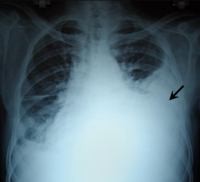
Photo from wikipedia
A 52yearold healthy woman presented with progressive shortness of breath as well as chest pain, nausea, and vomiting for the past month. Laboratory results revealed elevated lactate dehydrogenase and alphahydroxybutyric… Click to show full abstract
A 52yearold healthy woman presented with progressive shortness of breath as well as chest pain, nausea, and vomiting for the past month. Laboratory results revealed elevated lactate dehydrogenase and alphahydroxybutyric acid. A computed tomography (CT) scan showed that there was no spaceoccupying lesion in either lung, and there was pleural effusion in the right lung. The pericardium was thickened, and irregular soft tissue masses were seen in the right atrium and ventricular lateral wall, showing equal T1 and high T2 signal shadows. An enhanced scan showed that the soft tissues had irregular edge enhancement— approximately 4.0 cm × 6.2 cm in size— unclear borders, and a slightly high signal in the diffusionweighted imaging (DWI) sequence. A thoracentesis yielded 250 ml of hemorrhagic fluid, and slides were prepared using the disposable membrane cell collector method. Smears were stained with haematoxylin and eosin (HE), and the smear cytopathology showed that there was an abundance of cells on the smear, including atypical cells (Figure 1A), a few mesothelial cells, histiocytes, and lymphocytes. The atypical cells were clustered or scattered, and in the center of the clusters there was an amorphous dense substance that was strongly stained with eosin (Figure 1B). Most of the atypical cells were round and had an abundant eosinophilic cytoplasm and eccentric nuclei. The nucleus was round or oval, with rough chromatin and a distinct nucleolus. The pathological mitosis was easy to see (Figure 1C), and occasionally intranuclear inclusion bodies were observed (Figure 1D). Subsequently, we faded the HE stained smears and performed immunocytochemical (ICC) staining. The EliVisionTMplus twostep immunocytochemical method was used to detect the expression of corresponding antibodies. The antibodies and serum were purchased from Fujian Maixin Biological Co., Ltd. Immunocytochemically, the atypical cells were negative for CEA (clone COL1) (Figure 2A), TTF1 (clone SPT24), Napsin A (clone MX015), P40 (clone ZR8), P63 (clone MX013), WT1 (clone MX012), calretinin (clone MX027), desmin (clone MX046), D240 (clone D240), S100 (clone 4C4.9), and HMB45 (clone HMB45). However, the cells were positive for CD34 (clone QBEnd/10) (Figure 2B), CD31 (clone MX032) (Figure 2C), and vimentin (clone MX034).
Journal Title: Cytopathology
Year Published: 2022
Link to full text (if available)
Share on Social Media: Sign Up to like & get
recommendations!